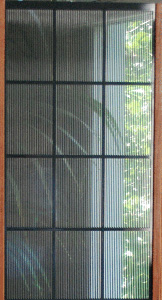
Electrostatic Loudspeakers (ESLs) have had a reputation for poor reliability, particularly in high-humidity environments. The basic cause of failure is the fact that ESLs operate at several thousand volts. This voltage is confined to very small spaces (typically less than two millimeters), which must be controlled by high-value electrical insulation if sufficient voltage to produce high output is to be used.
This insulation must be perfect as even the slightest flaw will allow a flow of electrons between the speaker's stator and diaphragm. This can cause the high-voltage static charge on the diaphragm to "leak" off, reducing the speaker's output and/or causing hissing or frying noises. Worse yet, it can release a sudden burst of electricity from the stator that will melt a hole in the speaker's diaphragm, leading to outright speaker failure.
Air is also an insulator, which helps control the high voltages present in an ESL. Some ESL manufacturers rely on the insulation of the air for good ESL performance. However, when moisture is present in the air (high humidity), the insulation qualities of the air is greatly reduced. Therefore, high humidity conditions increase the likelihood of leakage and arcing in ESLs.
The problem is compounded if there are any foreign objects between the speaker's diaphragm and stator. These objects (usually insects or dirt) eliminate the beneficial insulating effect of the air completely, often leading to shorting out of the speaker and damage to the diaphragm and stator insulation. An ESL's stator insulation must be able to confine the high voltage charge even with a foreign object present. This is a daunting challenge.
Additionally, the stator insulation must be so good that it will not allow any electricity to leak when the humidity is high. If it does, the output from the speaker will be reduced. This reduces sensitivity in full-range ESLs. In hybrid ESLs, leakage changes the frequency response of the speaker by reducing the output of the ESL compared to the woofer. The result is a thick, muffled sound quality when the speaker is played in high humidity conditions.
An ESL's diaphragm has a special coating that conducts electricity from a high voltage power supply within the speaker to form a static charge within the electrostatic panel. This coating is very specialized and among other things, must not be adversely affected by humidity, it must not corrode, it must not absorb water, it must be extremely smooth, it must be durable, and it must withstand constant flexing and acceleration as the diaphragm vibrates. If it cannot meet these requirements, it eventually fails to conduct electricity and the speaker fails.
These problems are all solved with the use of the Ultrastat panel. This panel does not use perforated metal as the basis for its stators. This is because perforated metal must be coated with insulation that is impossible to apply perfectly.
To achieve perfect insulation, Ultrastat stators are made of a high-value insulating material instead of metal. The necessary conductors are encapsulated within the insulation matrix to achieve flawless insulation. An added advantage is that the panel can be made to extremely precise tolerances for higher efficiency and improved cosmetics. This material is unaffected by humidity.
The diaphragm coating is the result of over thirty years of testing hundreds of materials for durability. The Ultrastat coating will not corrode and is embedded into the diaphragm material itself so that it cannot come off. It does not absorb water, so humidity has no effect on it. If an arc should form, this coating disperses it so that the arc does not cause a hole in the diaphragm.
The result of these technological advances is an electrostatic panel that is more durable than conventional moving-coil drivers. Extensive tests in extremely humid environments like Costa Rica and Asia have shown 100% reliability without any output loss over many years of use. There has never been a failure of an Ultrastat ESL. Sanders Sound Systems is proud to be the only ESL manufacturer to have a 100% reliable electrostatic speaker.
